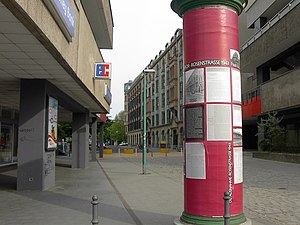This article needs additional citations for verification. (January 2021) |
Fabrikaktion (German pronunciation: [fabʁi:kakt͡sjoːn], 'Factory Action') is the term for the last major roundup of Jews for deportation from Berlin, which began on 27 February 1943, and ended about a week later. Most of the remaining Jews were working at Berlin plants or for the Jewish welfare organization. The term Fabrikaktion was coined by survivors after World War II; the Gestapo had designated the plan Große Fabrik-Aktion (Large Factory Action).[1] While the plan was not restricted to Berlin, it later became most notable for catalyzing the Rosenstrasse protest, the only mass public demonstration of German citizens which contested the Nazi government's deportation of the Jews.

- ^ Lutjens, Richard N. (2019). Submerged on the Surface: The Not-So-Hidden Jews of Nazi Berlin, 1941–1945. Berghahn Books. p. 60. ISBN 978-1-78533-455-9.
© MMXXIII Rich X Search. We shall prevail. All rights reserved. Rich X Search
